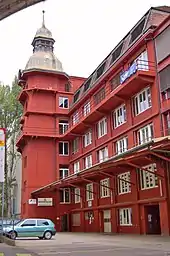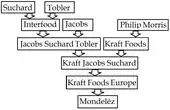Chocolat Suchard
Chocolat Suchard was a chocolate factory founded in Serrières (a neighborhood of Neuchâtel) by Philippe Suchard in 1826. It was one of the oldest chocolate factories in Switzerland.

History
.jpg.webp)

The Suchard chocolate factory took off thanks to his son Philippe (1834-1883), then to his son-in-law Carl Russ (1838-1925), who ran the chocolate company from 1884 to 1924.[1] After Philippe's death in 1884 in Neuchâtel, his daughter Eugénie Suchard and her husband Carl Russ-Suchard, took over the functioning of his factory.[2] Carl Russ-Suchard opened the first Suchard factory abroad in 1880 in Germany, at Lörrach.[3][4][5]
The Suchard factory used hydropower of the nearby river to run the mills. Grinding mill consisting of a heated granite plate, and several granite rollers moving forwards and backwards were used to produce chocolate. This design is still used to grind cocoa paste.[6]
Chocolate was not cheap or a product for everybody. Suchard struggled financially early in his career as a chocolatier. His success came in 1842, with a bulk order from Frederick William IV, king of Prussia, who was also the prince of Neuchâtel. This triggered a boom and soon his chocolates won prizes at the London Great Exhibition of 1851 and the Paris Universal Exposition of 1855.[7] By the end of the 19th century, Suchard had become the largest chocolate producer.[8]
The company mechanized its production and created the Milka chocolate brand for the Swiss market in 1901. Carl Russ-Suchard combined an unusual purple packaging with a Simmental cow symbolizing their use of milk.[9]
Having become a public limited company in 1905, Suchard was transformed into a holding company in 1930, marking the end of the family business after Willy Russ had sold his shares. Suchard continued its development abroad as well as on the Serrières site (30 kg of chocolate per day in 1826, 60 tons in 1924; 100 workers in 1875, 920 at the end of the 1960s) and diversified its products with various brands such as Suchard Express (a chocolate drink) and Sugus (fruit candies).[1]
Mergers
In 1970, Suchard merged with Tobler to become Interfood.[10] In 1982, Interfood was acquired by Klaus Johann Jacobs, and became part of the company Jacobs Suchard.[11][12] In 1987, the Suchard company acquired 66% of the shares of the Côte d'Or chocolate company.[13] In 1990, Philip Morris, also based in Neuchâtel, announced that they would buy Jacobs Suchard.[14] In 1993, Philip Morris combined Kraft General Foods Europe and Jacobs Suchard AG, renaming it Kraft Jacobs Suchard.[15] It spun off its chocolate and confectionery brands as Mondelez International as of 2012.[16] The Suchard factory in the Serrières Valley is no longer used for production. Mondelez moved production to the Toblerone factory in Bern in the 1990s.[17] In 2015, Mondelez opened a new production line for Milka and Suchard chocolates at its plant in Bludenz, Austria.[18]
See also
References
- "Suchard". Historical Dictionary of Switzerland. Retrieved 28 March 2022.
- "Philippe Suchard: de Boudry à l'Orient du Minaret" (in French). Retrieved 2008-09-09.
- "Milka Plant - Lörrach's best side and home of Milka tablets". Mondelēz International. Retrieved 10 February 2019.
- Schmid, Olivier (1999). ""Une fabrique modèle". Paternalisme et attitudes ouvrières dans une entreprise neuchâteloise de chocolats: Suchard (1870-1930)". Cahiers d'histoire du mouvement ouvrier. 15: 51–69.
- Huguenin, Régis (2009). "La photographie industrielle entre image documentaire et image publicitaire". Conserveries mémorielles [Online]. 6. Retrieved 10 February 2019.
- Moss, Sarah; Badenoch, Alexander (September 15, 2009). Chocolate : a global history. London: Reaktion Books. ISBN 978-1861895240.
- Voegtli, M. (2003). "Crise de foi dans l'industrie chocolatière Suchard : du paternalisme à l'État social (1870-1940)". A Contrario. 1 (2): 90–115. doi:10.3917/aco.012.115. Retrieved 10 February 2019.
- Clarence-Smith, William Gervase (September 2, 2003). Cocoa and chocolate, 1765-1914. Routledge. p. 59. ISBN 9780415215763.
- Werner, Florian (February 21, 2012). Cow : a bovine biography (1st U.S. ed.). Vancouver: Greystone Books. pp. 63–64. ISBN 978-1553655817. Retrieved 10 February 2019.
- Bailey, Elizabeth (1981-02-04). "CHEAP CHOCOLATE WORRIES THE SWISS". The New York Times. Retrieved 2015-09-23.
- "Kraft Jacobs Suchard AG History". Funding Universe. Retrieved 10 February 2019.
- Beckett, Edward (September 13, 2008). "Chocolate King Jacobs Dies". Forbes. Retrieved 10 February 2019.
- Squicciarini, Mara P.; Swinnen, Johan (January 21, 2016). The economics of chocolate (First ed.). Oxford, United Kingdom: Oxford University Press. p. 123. ISBN 9780198726449. Retrieved 9 February 2019.
- Ramirez, Anthony (June 23, 1990). "Philip Morris Will Buy Suchard's Europe Units". The New York Times. Retrieved 9 February 2019.
- "Philip Morris forms Kraft Jacobs Suchard in Europe". UPI. September 8, 1993. Retrieved 9 February 2019.
- Strom, Stephanie (May 23, 2012). "For Oreo, Cadbury and Ritz, a New Parent Company". The New York Times. Retrieved 9 February 2019.
- "On the Trails of Swiss Chocolatier Suchard in Neuchâtel". Newly Swissed. June 22, 2015. Retrieved 9 February 2019.
- Abdulla, Hannah (24 July 2015). "Mondelez opens Milka line at Bludenz plant". Just Food. Retrieved 10 February 2019.
External links
 Media related to Suchard at Wikimedia Commons
Media related to Suchard at Wikimedia Commons